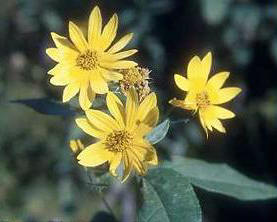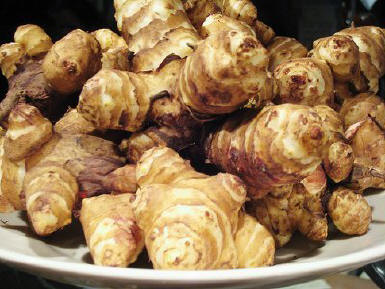|
Growing Jerusalem Artichokes
Bobbi Little
Adams County Master Gardener
 Jerusalem artichokes may be a different kind of vegetable for you to try in your garden since they are
very easy to grow. If you are thinking of the globe-type artichoke, don’t. They aren’t artichokes at all, and they don’t come from Jerusalem. Instead, think more along the
lines of a misshapen potato. They are native to North America, found along the eastern seaboard from Georgia to Nova Scotia. Several stories exist about how they got their
name. An early reference to the tubers tasting somewhat like artichokes account for part of the name and a corruption of the French word ‘girasol’ meaning rotating with the
sun might have resulted in ‘girasol’ being heard as ‘Jerusalem.’ When their explorers came home, Europeans heard them calling these newly discovered vegetables girasol
artichokes and thought they said Jerusalem artichokes – and the name just seemed to stick. They are also sometimes known as sunchokes or sunroots. They are actually members
of the sunflower family, which is evident when you see the blooms at the end of summer as they turn to face the sun. Jerusalem artichokes may be a different kind of vegetable for you to try in your garden since they are
very easy to grow. If you are thinking of the globe-type artichoke, don’t. They aren’t artichokes at all, and they don’t come from Jerusalem. Instead, think more along the
lines of a misshapen potato. They are native to North America, found along the eastern seaboard from Georgia to Nova Scotia. Several stories exist about how they got their
name. An early reference to the tubers tasting somewhat like artichokes account for part of the name and a corruption of the French word ‘girasol’ meaning rotating with the
sun might have resulted in ‘girasol’ being heard as ‘Jerusalem.’ When their explorers came home, Europeans heard them calling these newly discovered vegetables girasol
artichokes and thought they said Jerusalem artichokes – and the name just seemed to stick. They are also sometimes known as sunchokes or sunroots. They are actually members
of the sunflower family, which is evident when you see the blooms at the end of summer as they turn to face the sun.
 Some time ago, I bought Jerusalem artichoke tubers at a health food store and ate them raw on salads and also cooked them with a bit of
garlic olive oil. They remind me of a potato with a bit more personality. Crunchy when raw, soft when cooked, they contain natural insulin, are a good source of potassium,
and are almost completely starch, fat, and cholesterol-free. The poor things are homely looking and should be scrubbed before eating them, but they shouldn’t be peeled to
maximize nutritional benefits. Some time ago, I bought Jerusalem artichoke tubers at a health food store and ate them raw on salads and also cooked them with a bit of
garlic olive oil. They remind me of a potato with a bit more personality. Crunchy when raw, soft when cooked, they contain natural insulin, are a good source of potassium,
and are almost completely starch, fat, and cholesterol-free. The poor things are homely looking and should be scrubbed before eating them, but they shouldn’t be peeled to
maximize nutritional benefits.
I thought I’d like to try growing them, so I ordered the tubers from a catalog, and they arrived with no cultivating instructions. I planted
them like a potato, and up they came. Did they ever! They grew to be over 8 feet tall and shaded some of my other vegetables. The yellow flowers on top were puny, but pretty.
I had no idea they’d get that big, so I called the company that sold them to me for more information on how to grow them properly. In the business world, we used to call this
type of nitwit thinking, ready-shoot-aim. I know better.
 You should plant whole or pieces of tubers in early spring 3 to 5 inches deep in rows 36 to 42 inches wide and 15 to 24 inches between
plants. Tubers form in August but should not be harvested till after frost. The longer they stay in the ground, the sweeter the flavor. They produce an enormous number of
tubers. One plant will feed your neighbors and your own family for some time. I kept them in the ground all winter, threw some straw overtop and ate Jerusalem artichokes well
into the winter until the ground was frozen solid. You should plant whole or pieces of tubers in early spring 3 to 5 inches deep in rows 36 to 42 inches wide and 15 to 24 inches between
plants. Tubers form in August but should not be harvested till after frost. The longer they stay in the ground, the sweeter the flavor. They produce an enormous number of
tubers. One plant will feed your neighbors and your own family for some time. I kept them in the ground all winter, threw some straw overtop and ate Jerusalem artichokes well
into the winter until the ground was frozen solid.
What’s the downside to this vegetable? There are two that come to mind immediately. If you overcook Jerusalem artichokes, they are not
forgiving like a potato. They will turn into a mushy mess that you won’t want to eat. Cook them only until a fork pierces them easily like a potato, erring to more on the
firm side. At that point, stop cooking them. I’ve steamed them and also sautéed them. Steaming is faster.
The other downside is that it is nearly impossible to remove all the tubers from the area in the garden where they were grown, so you will
have plants by the gazillions next year. Someone else warned me, and I thought this would be a great problem to have because they wouldn’t need planting again. However, if
you decide to rotate your crops as you should and plant something else, you’ll be cursing when they all start coming up as volunteer plants. Just pick them if you want them
removed, and don’t let them set tubers, which they typically do in August. A single microdot of this tuber left in the garden over the winter will start new plants in the
spring. You’ve been warned.
Read other articles on growing herbs or vegetables
Read other
articles by Bobbi Little
|